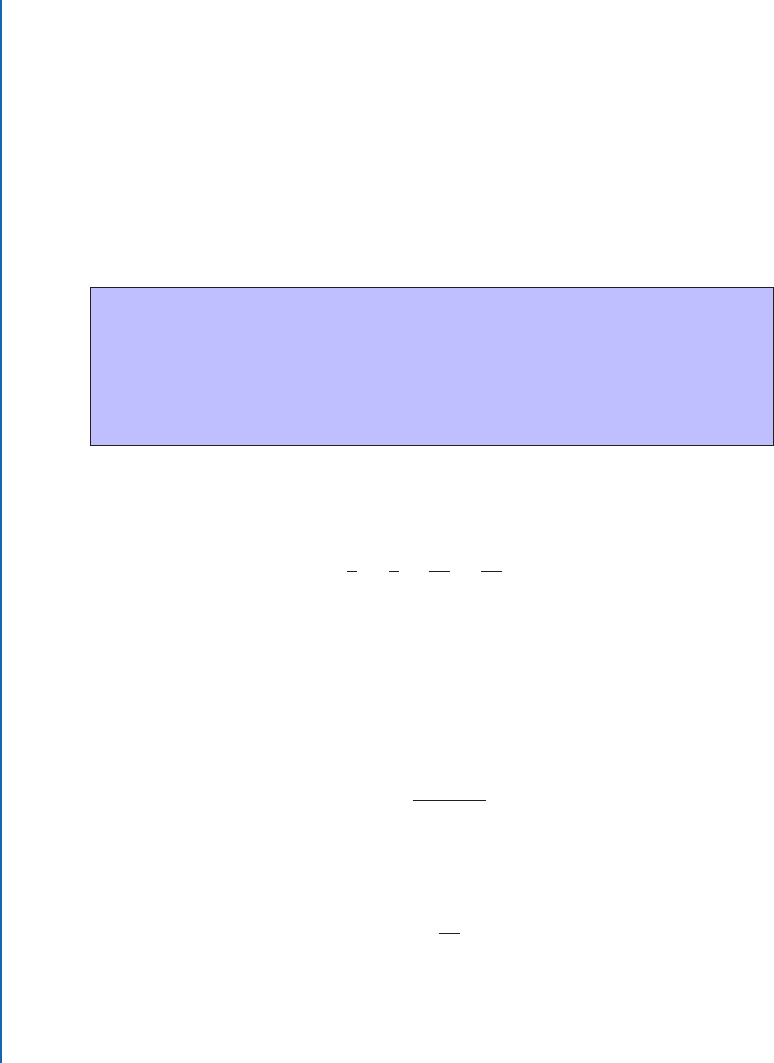
4.2. SERIES CONVERGENCE TESTS 131
Solution:
is series has the form of a p-series with p D 1=2. Since 1=2 1, we conclude the se-
ries diverges.
˙
e next two tests leverage series we already understand to resolve even more series. e tests
depend on various forms of comparison of a series under test to a series with known convergence
or divergence behavior.
Knowledge Box 4.11
e comparison tests
• If
1
X
nD0
x
n
converges and 0 y
n
x
n
for all n, we have that
1
X
nD0
y
n
also converges.
• If
1
X
nD0
x
n
diverges and y
n
x
n
0 for all n, we have that
1
X
nD0
y
n
also diverges.
e colloquial versions of the comparison tests are pretty easy to believe. e first says, of a series
with positive general terms, that if it is smaller, term by term, than another series with a finite
sum, then it has a finite sum. e second reverses that: saying that, if a series is larger, term by
term, than another series with an infinite sum, then it has an infinite sum.
Example 4.27 Determine if
1
X
nD1
1
n=3
converges or diverges.

132 4. SEQUENCES, SERIES, AND FUNCTION APPROXIMATION
Solution:
Notice that, for n 1,
n n=3
1
n
1
n=3
So 0
1
n
1
n=3
, which permits us to deduce that the series in the example diverges by
comparison to the harmonic series, which is known to diverge.
˙
Example 4.28 Determine if
1
X
nD0
1
2
n
C 5
converges or diverges.
Solution:
e key to using the comparison test is to find a good known series to compare to. In
this case the geometric series with ratio 1/2 is natural.
2
n
2
n
C 5
1
2
n
1
2
n
C 5
1
2
n
1
2
n
C 5
Which means that the general term of the convergent geometric series
1
X
nD0
1
2
n
is greater than the general term of our target series. Since all terms are positive, this tells us that
we may conclude the target series converges, by comparison.
˙

4.2. SERIES CONVERGENCE TESTS 133
e next test is one of the most all-around useful tests. It permits us to resolve any series drawn
from a rational function, for example, by checking to see which p-series a rational function is
most like.
Knowledge Box 4.12
e limit comparison test
Suppose that
1
X
nD0
x
n
and
1
X
nD0
y
n
are series, and that
lim
n!1
x
n
y
n
D C
where 0 < jC j < 1 is a constant. en, either both series converge or both series di-
verge.
Example 4.29 Determine if
1
X
nD1
n C5
n
3
C 1
converges or diverges.
Solution:
Perform limit comparison to
1
X
nD1
1
n
2
lim
x
n
y
n
D lim
n!1
nC5
n
3
C1
1
n
2
D lim
n!1
n C5
n
3
C 1
n
2
1
D lim
n!1
n
3
C 5n
2
n
3
C 1
D 1
Since 0 < 1 < 1, we can conclude that
1
X
nD1
n C5
n
3
C 1
converges, because
1
X
nD1
1
n
2
is a convergent
p-series.
˙

134 4. SEQUENCES, SERIES, AND FUNCTION APPROXIMATION
Notice that choosing a p-series with p D 2 was exactly what was needed to make the ratio
of the general terms of the series be something that had a finite, non-zero limit. e limit
comparison test is useful for putting rigour into the intuition that one series is “like” another.
e next test uses the fact that if you have a sum of positive terms that is finite, making some or
all of those terms negative cannot take the sum farther from zero than the original finite sum –
leaving the sum finite.
Knowledge Box 4.13
e absolute convergence test
If
1
X
nD0
jx
n
j converges, then so does
1
X
nD0
x
n
.
Example 4.30 Prove that
1
1
4
C
1
9
1
16
C
1
25
converges.
Solution:
e series in question is given as an obvious pattern – begin by pulling it into summa-
tion notation:
1
X
nD1
.1/
nC1
n
2
If we take the absolute value of the general terms of this series, we obtain the series:
1
X
nD1
1
n
2
We know this to be a convergent p-series. We may deduce that the series converges.
˙

4.2. SERIES CONVERGENCE TESTS 135
Definition 4.9 If
1
X
nD0
jx
n
j converges, then we say the series
1
X
nD0
x
n
converges in absolute value.
is means we can restate Knowledge Box 4.13 as: “A series that converges in absolute value,
converges.”
e next test uses the fact that if you go up, then down by less, then up by even less, and so on,
you end up a finite distance from your starting point.
Knowledge Box 4.14
e alternating series test
Suppose that x
n
is a series such that x
n
> x
nC1
0, and suppose that lim
n!1
x
n
D 0.
en the series
1
X
nD0
.1/
n
x
n
converges.
Example 4.31 Show that
1
X
nD1
.1/
n
p
n
converges.
Solution:
We already know that lim
n!1
1
p
n
D 0, and the terms of the series clearly get smaller as n
increases. So, we may conclude this series converges by the alternating series test.
˙
e next two tests both check to see if a series is like a geometric series and deduce its
convergence or divergence from that similarity.
..................Content has been hidden....................
You can't read the all page of ebook, please click here login for view all page.
